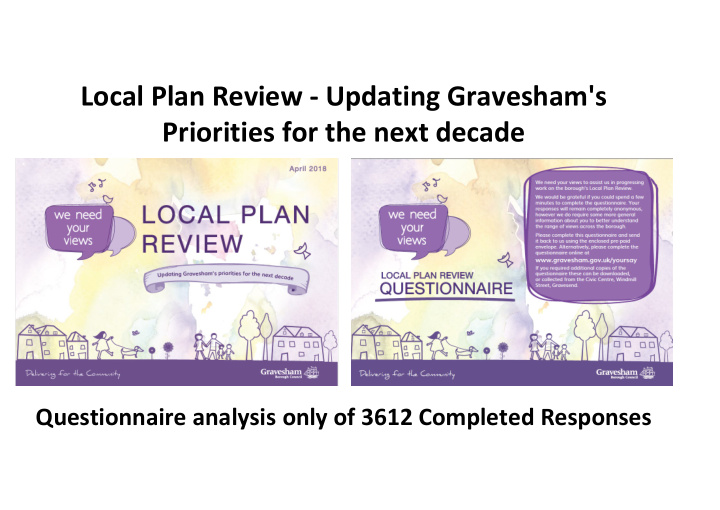



Local Plan Review - Updating Gravesham's Priorities for the next decade Questionnaire analysis only of 3612 Completed Responses
Process and Timetable Infrastructure Evidence Base Requirements National, Regional Legislation, Appraisals e.g. Policy and Guidance • Sustainability Appraisal • National Planning Policy • Strategic Environmental Site Allocations and Development Framework (NPPF) Assessment Management Policies Document • National Planning Practice • Habitats Regulations Guidance (NPPG) Assessment • Acts and Regulations etc Community and Duty to Co-operate Stakeholder Involvement KCC, EDC, South East LEP, e.g. Regulation 18 and 19 neighbouring districts, etc consultations Regulation 18 Regulation 18 Evidence Regulation 19 Consultation Consultation Submission Examination Adoption Gathering Consultation Stage 1 Stage 2 April – June 2018 Autumn 2019 Summer 2020 Late 2020 Early 2021 Summer 2021
Summary of Gravesham’s Population
Summary of Gravesham’s Population Falling working-age population Ageing Population
Gravesham’s Population by Age Group vs Age Groups of Respondents
Where do respondents live? 2017 Mid Year Population Estimates for Wards (Experimental) identify that approx. 21% of Gravesham’s residents live in the rural area and 79% in the urban area. (The rural area includes the urban component of Shorne, Cobham and Luddesdown Ward as the figures cannot be disaggregated)
Housing tenure of Respondents
Economic status of Respondents
Question 5: In England, the Green Belt is largely undeveloped land around or between large urban areas on which building is not allowed. The purposes of this, according to the National Planning Policy Framework, are to prevent large urban areas from spreading out or merging together, and in some cases to preserve the character of historic towns and cities. However, it can be argued that it is necessary to build on parts of the Green Belt to meet housing and other needs. To what extent do you agree or disagree, in principle, that existing Green Belt land in the borough should be retained in its current form and not be built on?
Comparing responses to Q5 and Q1 Of those respondents who want green belt protected Of those respondents who want green belt protected more agree that local authorities should be proactive more agree that local housing needs should be met about meeting housing needs when compared to those who disagree
Comparing responses to Question 5 & Question 2/6 More respondents are for protecting the Green Belt and Even though respondents want the Green Belt strongly against any new development, than those who protected there is some support for specialist housing, disagree with any new development whilst for affordable and market housing there is very little support
Some support Very limited support Some support
Question 7: Another Option… Responses vary, but include: • Force developers to build on brownfield sites • Stop selling council houses • Housing need should be re-assessed following Brexit referendum • Redevelop town as more residential less retail • Local area cannot cope with additional development, roads, doctors, hospitals, schools at full capacity • Challenge the figures, seek to reduce the housing figure with central government.
Recommend
More recommend